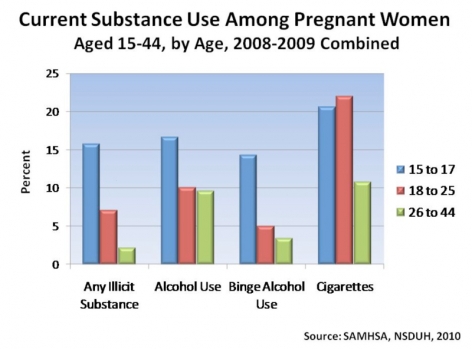Topics in Brief: Prenatal Exposure to Drugs of Abuse
Revised May 2011
Drug Abuse among Pregnant Women in the U.S.
Exposure to substances of abuse can affect individuals across the lifespan, starting in utero. While most pregnant women do not abuse illicit drugs, combined 2008 and 2009 data from the National Survey on Drug Use and Health found that among pregnant women ages 15 to 44, the youngest ones generally reported the greatest substance use. Also, pregnant women ages 15 to 17 had similar rates of illicit drug use (15.8 percent or 14,000 women) as women of the same age who were not pregnant (13.0 percent or 832,000 women).
Prenatal drug use has been associated with potentially deleterious and even long-term effects on exposed children. However, estimating the full extent of the consequences of maternal drug abuse is difficult for many reasons. Multiple individual, family, and environmental factors—such as, nutritional status, extent of prenatal care, neglect or abuse, socioeconomic conditions, and many other variables—make it difficult to determine the direct impact of prenatal drug use on the child. Moreover, some negative outcomes in exposed children can be ameliorated by supportive home environments and quality parenting. Still, a number of drugs can have negative consequences, as shown by research findings summarized below.
The Effects of Prenatal Drug Exposure—What the Research Shows
Nicotine
Smoking during pregnancy is associated with a range of adverse outcomes for the fetus, newborn, and the individual as he/she develops. Carbon monoxide and nicotine from tobacco smoke may interfere with fetal oxygen supply—and because nicotine readily crosses the placenta, it can reach concentrations in the fetus that are much higher than maternal levels. Nicotine concentrates in fetal blood, amniotic fluid, and breast milk, exposing both fetuses and infants to toxic effects.
The adverse effects of smoking during pregnancy can include increased risk for stillbirth, infant mortality, Sudden Infant Death Syndrome, preterm birth, respiratory problems, slowed fetal growth and low birth weight—an important risk factor for later developmental delay. Low birth weight has been shown to be dose-dependent, which means the more a woman smokes during pregnancy, the more infant birth weight is reduced. Smoking during pregnancy can also affect cognition and is associated with behavioral problems. In addition, smoking more than a pack a day during pregnancy nearly doubles the risk of the child becoming addicted to tobacco if he or she starts smoking.
Even second-hand exposure to cigarette smoke can cause problems. For example, strong associations have been found between second-hand smoke and low birth weight and premature birth. Exposure during the postnatal period has been associated with a number of physical health outcomes, including Sudden Infant Death Syndrome, respiratory illnesses (asthma, respiratory infections, and bronchitis), ear infections, cavities, and increased medical visits and hospitalizations.
Alcohol
Alcohol is one of the most widely abused substances during pregnancy, and its effects on fetal development and infant outcomes have been well studied. More information on alcohol and pregnancy can be found on the National Institute on Alcohol Abuse and Alcoholism's website at http://pubs.niaaa.nih.gov/publications/DrinkingPregnancy_HTML/pregnancy.htm
Cocaine, Marijuana, and Other Illicit Drugs
Illicit drug use during pregnancy has been associated with a variety of adverse effects, though more research is needed to draw causal connections. Effects may be subtle, and generally range from low birth weight to developmental deficits affecting behavior and cognition. For example, impaired attention, language, and learning skills, as well as behavioral problems, have been seen in children exposed to cocaine and marijuana, all of which can affect success in school. Methamphetamine exposure has been associated with fetal growth restriction, decreased arousal, and poor quality of movement in infants. And although use of heroin (an opiate) during pregnancy has been associated with low birth weight, the impact of prescription opiate abuse on pregnancy outcomes is not well understood.
Promising Treatment Approaches for Pregnant Women

Medications
Research shows that some medications that are effective in drug-abusing populations can also be beneficial for pregnant women (and their babies). For example, methadone maintenance combined with prenatal care and a comprehensive drug treatment program can improve many of the detrimental maternal and neonatal outcomes associated with untreated heroin abuse, although newborns exposed to methadone during pregnancy typically require treatment for withdrawal symptoms. Another medication for opioid dependence—buprenorphine—has recently been shown to produce fewer neonatal abstinence symptoms in babies than methadone, resulting in shorter infant hospital stays.
Behavioral Treatments
NIDA-supported research has established that the value of evidence-based treatments in changing drug abuse and addiction behaviors in the general population also extends to pregnant women. One example is contingency management, where participants are given incentives, such as small cash amounts, privileges, or prizes, for maintaining abstinence. Compared to a standard treatment condition, motivational incentive approaches appear to increase treatment retention and prolong abstinence in pregnant women with cocaine, opiate, and nicotine dependence. In general, it is important to closely monitor women who are trying to quit drug use during pregnancy, and to adjust treatment as needed.
Comorbidity
Research suggests that pregnant women with mood or anxiety disorders are more likely to have a substance use disorder as well, and vice-versa. These studies call for more treatment research on co-occurring psychiatric and substance use problems in pregnant women, including an examination of mood-focused smoking cessation interventions.
Future Research
NIDA is supporting multiple research projects examining how early exposure to drugs may increase drug abuse vulnerability during adolescence and young adulthood—specifically, how drug exposure affects the structure, function, and connectivity of the developing brain and how genetics can influence these effects. The development of interventions for drug-exposed infants and children is also a priority.



